
Cherry blossoms turn Tidal Basin pink
WASHINGTON, D.C.— One million visitors flock to this city every spring for the extraordinary opportunity to view the nation’s capitol through cherry-tinted vision.
“You know that spring is truly here when the cherry blossom trees obstruct your vision with all their blooms,” said Judy Reiter, a resident of Washington who has a pink-themed picnic on the edge of the Tidal Basin in annual celebration of the blossoming cherry trees surrounding the water. “There is no better time to enjoy D.C. than right now.”
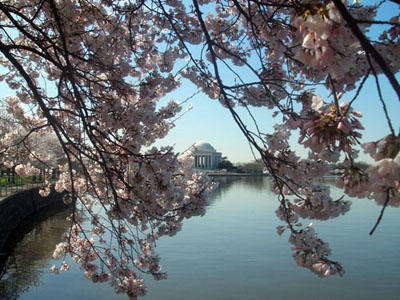 |
The largest collection of cherry trees is at the Tidal Basin, near the Jefferson Memorial (Photo by Elise Fender). |
The majority of the cherry trees are planted along the famous Tidal Basin of the Potomac River, within sight of the Jefferson Memorial and not very far from the National Mall, the Washington Monument and the new World War II Memorial.
A variety of cherry trees, planted throughout the National Mall and Memorial Parks, are a gift of solidarity from Japan to the United States. The trees are most noted for briefly blossoming into an explosion of pink and white flowers at the end of March, lasting until mid-April.
“I think world friendship is what the trees represent,” said Sean Petersen, an eighth grade teacher from Pennsylvania who travels to Washington with his students each spring in order to see the cherry blossoms. “We come to the Tidal Basin because the largest population of cherry trees is located here.”
Petersen believes that the trees’ proximity to the Franklin Delano Roosevelt Memorial is emblematic.
“I always explain to my students how special it is that the trees share land with a memorial honoring a president who believed the world was one big neighborhood, because the blossoms are a symbol of neighborly love,” Petersen said.
The symbolic significance of the blossoms is honored by the National Cherry Blossom Festival, a two-week event held every year while the cherry trees are at peak bloom.
“The whole festival is centered on friendship and unity,” said Sue Murphy, the enthusiastic volunteer coordinator for the festival. “It is a very multi-cultural event.”
The multi-cultural flare comes to life with diverse ethnic music that visitors can enjoy while strolling around the Tidal Basin or even boating in its water.
| Pixie Windsor and Judy Reiter of Washington, D.C., enjoy a pink themed picnic in a grove of cherry trees to celebrate the peaking blossoms (Photo by Elise Fender). | 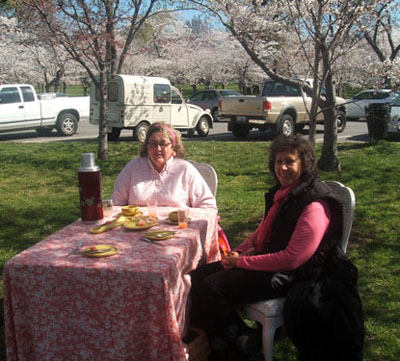 |
The ethnic significance of the cherry trees goes back to 1912 when First Lady Helen Taft wanted to beautify Washington D.C. Mrs. Taft and the wife of a Japanese Ambassador, Viscountess Chinda, stood together on the northern bank of the Tidal Basin and ceremoniously planted the first two Yoshino Cherry Trees.
“It is important not to forget the history of how these trees came to America,” said Murphy.
Many of the trees planted on the grounds of the Washington Monument were a gift from Japan to the First Lady, Lady Bird Johnson, in 1965.
Today the original two trees, marked by large bronze plaques, still stand at the south end of SW 17th Street.
In Japanese culture, the cherry blossoms, which are called “sakura,” are a symbol of transformations, according to the National Park Service.
“As a Japanese American, to me the cherry blossoms are special because they mark change and new growth,” said Jean Gize, who traveled from San Jose, Calif., to volunteer for the Cherry Blossom Festival. “They should be celebrated by all cultures.”
In order to educate visitors on the history and cultural impact of the cherry trees, the National Park Service holds several free programs during the Cherry Blossom Festival. The programs include Ranger Talks, Bloomin’ Junior Ranger Programs, Lantern Walks and Bike Tours.
“I would recommend for visitors to see and do stuff only offered during the festival,” said Murphy, the volunteer coordinator.
Park rangers share interesting anecdotes about the cherry trees ranging from Japanese folklore about why the blossoms are pink to the method horticulturists use to determine peak bloom dates.
Specific times, locations and descriptions of the programs are easily found in brochures throughout the National Mall and Memorial Parks during the festival as well as on the National Cherry Blossom Festival web page, http://www.nationalcherryblossomfestival.org.
Some visitors, however, prefer to observe the blossoms on their own.
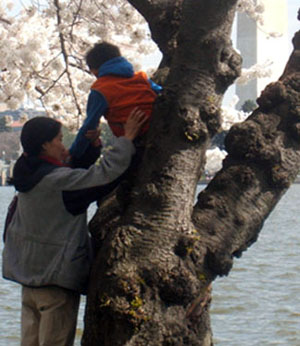 |
A mother lifts her son up to get a closer look at a Yoshino Cherry Tree blossom at the Tidal Basic. The Washington Monument is in the background (Photo by Elise Fender). |
“We have spent the whole day on foot, just walking around and looking up and enjoying the awesome sight of the trees overhead,” said Deborah Jay, who traveled with her husband and son from New Jersey for the festival. “It is our first time here, so we are just trying to take it all in.”Jay, dressed wittingly in pink, was pleased that her five-year-old son, John, was able to appreciate the beauty.
“I think they look like giant snowballs,” John said about the blossoms.
The “snowball” blossoms belong to the Yoshino cherry tree, which is the most populous and recognizable of all the trees, according to the National Park Service. Twelve different varieties of cherry trees were represented in the initial gift from Japan. Other species of cherry trees include Kwanzan, Akebono and the Weeping Japanese Cherry.
Just as there are a dozen different types of cherry trees, there are a dozen different ways to celebrate their blossoming.
“We are celebrating with a cherry pink picnic,” said cherry blossom devotee Pixie Windsor, of Washington. “We have pink ham, cherry scones and deviled eggs dyed pink.”
Windsor and her friend Judy Reiter have recognized the peak blossom days with cherry themed picnics for seven years.
“Every year our celebrations get more elaborate,” Reiter said. “This year we have pink chairs, next year we are hoping for a pink couch.”
Cherry blossom spectators not only honor the cherry blooms with pink themed meals, many also dress to match the colors of the blossoms.
“I just saw two little girls in matching pink dresses with pink ribbons,” Windsor said. “It is sort of an unwritten tradition to wear pink when you come visit the cherry blossoms.”
| Cherry blossom observers walk along the Tidal Basin under blossoming Yoshino Cherry Trees (Photo by Elise Fender). | 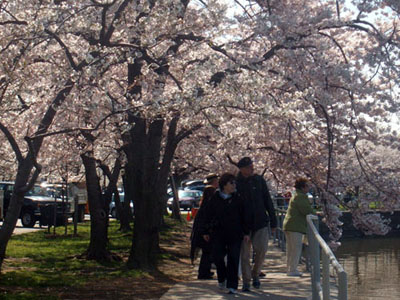 |
Windsor and Reiter were both dressed in pink from head to toe.
“We make a big deal out of the blossoms because it is just such an unusual spectacle,” Windsor said. “It is so beautiful that it actually has the power to put people in good moods.”
In addition to thinking pink, another way for visitors to celebrate the cherry blossoms is to attend the many events organized by the National Cherry Blossom Festival.
According to Diana Mayhew, the festival’s executive director, more than 200 performances and events occur in conjunction with the festival, most of which focus on the culture of Japan. These events include sushi tasting, a parade and Zen gardening lessons.
“We start planning all the aspects of each year’s festival about five days after the previous festival ends,” Murphy, the volunteer coordinator, said. “We look at which events were meaningful and which were not, and then try to create the best possible festival.”
The National Cherry Blossom Festival began as a one-week celebration in 1935 and expanded to its current duration of two weeks in 1994, according to the National Park Service. The festival weeks are determined based on the average date that the Yoshino Cherry Trees reach their peak bloom; meaning 70 percent of the blossoms are open.
According to Robert DeFeo, chief horticulturist for the National Park Service, unseasonably cold or warm weather can push back or pull forward the peak bloom date, but on average it is April 4.
In order to ensure that the cherry trees continue to thrive for future generations, the National Park Service works hard to protect them. Colorful signs and brochures throughout the National Mall and Memorial Parks remind visitors to not pick the flowers, put the flowers in their hair, or climb on the trees.
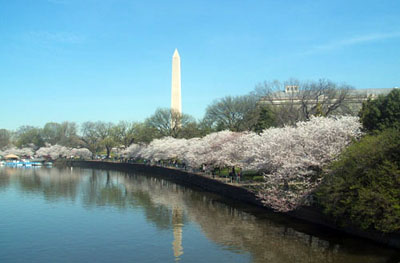 |
Cherry tree blossoms along the Tidal Basin create a bright pink blooming foreground to the Washington Monument (Photo by Elise Fender). |
Because of efforts to care for the cherry trees, there are approximately 3,750 trees blossoming throughout Washington, according to the National Park Service. These trees are not just located around the Tidal Basin; they can also be enjoyed at East Potomac Park and on the grounds of the Washington Monument.
For Murphy, those are 3,750 reasons to come to Washington in the short window of time that the trees are in bloom.
“Everybody should see the cherry blossoms at some point in their life,” Murphy said. “When you see the pretty blooms and hear about their meaning, you just get hooked.”
If You Go
- Peak bloom dates, festival dates and event dates vary year to year, check http://nationalcherryblossomfestival.org for up-to-date information.
- The 2008 Festival Dates are March 29 to April 13, 2008 with the Parade on Saturday, April 12.
- The Tidal Basin is accessible by car, Metrorail and Metrobus. Parking for cars is located at 1500 Maine Avenue SW. The closest Metrorail station is the Smithsonian Metro Station on the Blue & Orange lines. The closest intersection services by Metrobus is 14th Street & C Street, SW. The Ronald Reagan Washington National Airport-Pentagon-DC line (13A, 13B, 13F, 13G) For a timetable of these bus lines, visit http://www.wmata.com/timetables/bus.
- A walking tour is held on the Saturdays and Sundays of the festival by Washington Walks. A bike tour is held every day of the festival by Bike the Sites. Additionally, the National Park Service offers walking tours led by park rangers.
- Pets are welcome, but must remain on a leash at all times.
- For more information: Call the Festival Hotline at 202-547-1500.
- Tune into the National Mall and Memorial Parks visitor information radio station at 1670 AM.

Comments are Closed